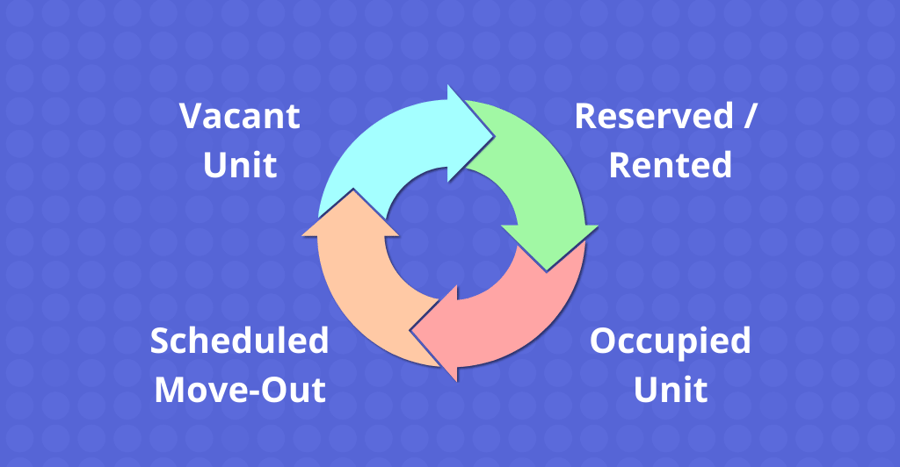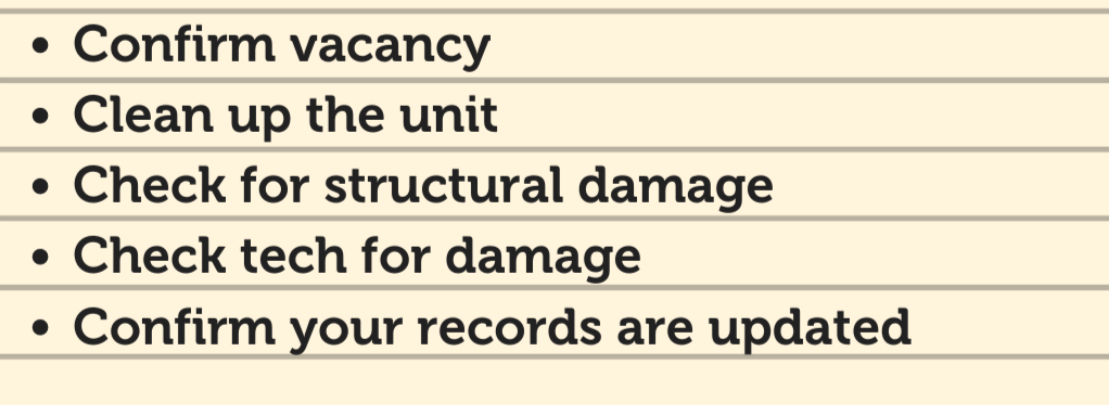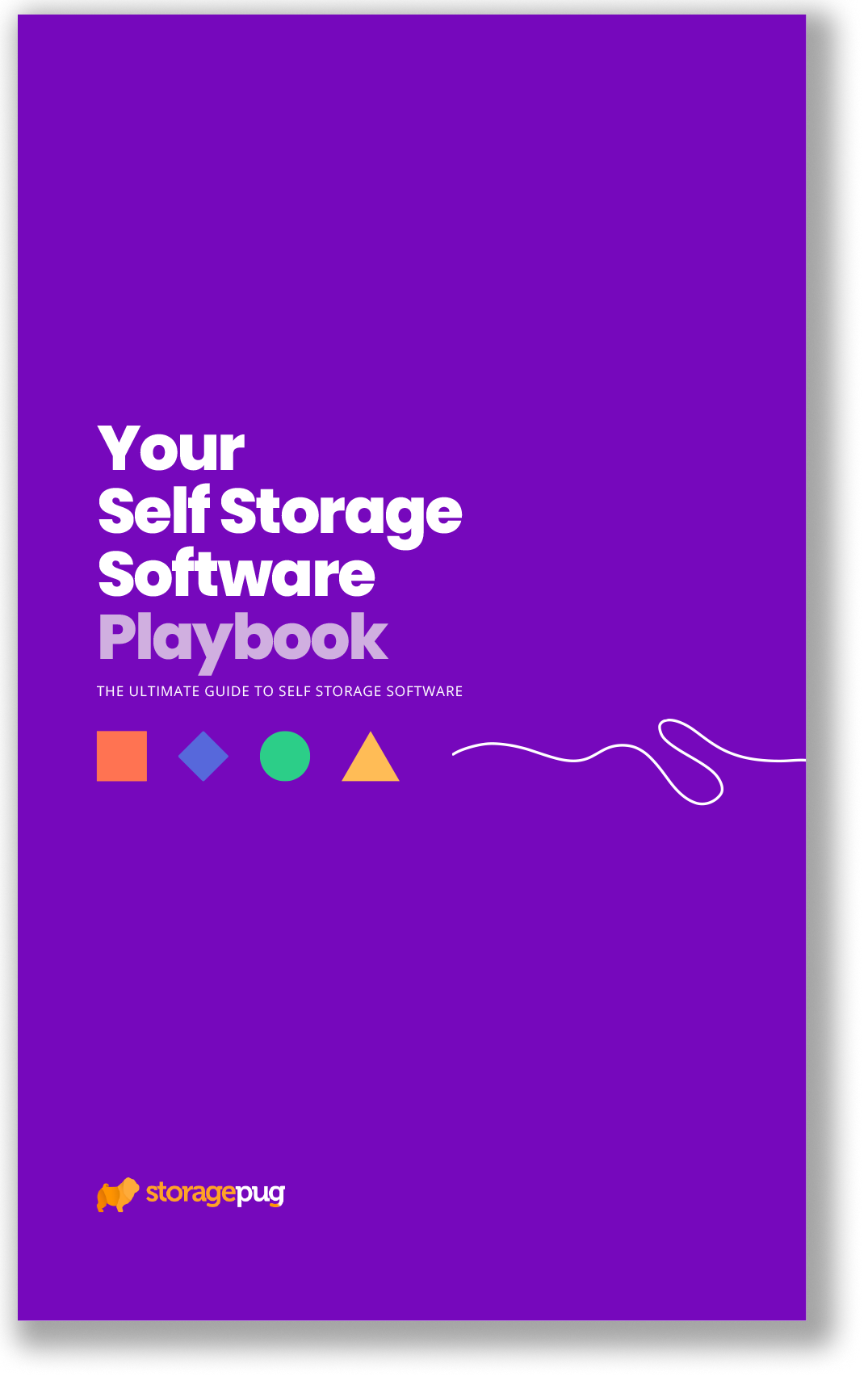Menu
February 8, 2022


Managing your self storage facility and its storage units isn’t always fun. We get it. Who can blame you?
Depending on the size of your self storage facility, you could have hundreds of storage units to keep track of. And even if you don’t have that many, there are a lot of tasks associated with storage unit management. Whether it’s tracking their status, prepping them for new move-ins, or just making sure they’re not being used without a lease, this is a huge part of your daily job when you work in self storage.
So let’s talk about the journey of a storage unit, how you keep track of it, and how to make that easier!
But wait, a storage unit doesn’t really go anywhere. What kind of journey could it possibly have?
A unit’s journey is its lifecycle from empty to leased to empty again. That includes everything in between and a variety of different paths. The self storage move-ins and move-out phases, overlocked and auction status, all of it is part of your storage unit’s journey.
So, what are the stages of that lifecycle?

These are fairly simple concepts that you’re no doubt familiar with. That also means you’re probably familiar with how easy it is for those simple things to become complicated when you are dealing with a hundred or more storage units.
Let’s take a look at each stage of storage unit management in more detail and talk about how to manage self storage units in a more convenient way, including using software to help!
Whether you’ve opened a new self storage facility and haven’t filled your units or you’re looking at a recently vacated self storage unit, at some point, you’ve got an empty storage unit on your hands.
What do you do now?
After a tenant moves out (or before the unit has even seen a tenant), there are some important tasks to complete. You should make sure the storage unit remains clean, first off. There could also be maintenance concerns, and that is especially important with climate-controlled storage units.

Even a unit that hasn’t been occupied for a while could need maintenance, so don’t think it’s good to go just because a tenant hasn’t been there for a month!
Of course, we’ve missed a major part of a self storage owner or storage unit manager’s job when it comes to storage units during this stage: making sure they’re actually empty. Whether you’re keeping track of unit status the old-fashioned way with a spreadsheet or using your self storage property management software, neither of those resources can tell you for sure if a storage unit is vacant.
This means hitting the halls and checking the unit in person. After all, you never know if someone has decided to sneakily move their items in (or not move them out) without knowing or paying you!
Pug Pro Tip: Your self storage PMS might include helpful features like a customizable facility map that make it easy to see unit statuses at a glance. Having this site map on a mobile device as you make your rounds is an easy way to see if you have any unannounced visitors!

There are different applications for self storage reservations and rentals. While most self storage software includes reservation functionality, not every operator makes use of it.
With reservations, there's a waiting period before a move-in occurs. Maybe there is no available storage unit for the customer and are added to a waitlist, or maybe they are wanting to rent at a future date.
For rentals, it's a lot more straightforward—they've rented their storage unit, and a move-in date is set.
There’s a lot to track for when you’re dealing with a move-in.
Thankfully, there are a lot of handy tools and strategies to deal with this process in today’s self storage industry. Most self storage unit management software will even automate some of the steps, such as switching the unit’s status in your facility map and database.
Making sure to keep track of these changes—and having a standardized process for doing so—is critical to help you save time and energy down the road.

Still, there are some things you will still need to do manually. You probably know what they are, too:
While you might think it's obvious what to do, a customer doesn’t always know what to expect when they become your tenant and move in. Make sure that—in addition to preparing the actual unit—you prepare your new tenant to give them the best possible experience. This includes using great self storage unit photos, so the customer knows what they're renting ahead of time!
Pug Pro Tip: Here’s a Pro Tip from Kim at Patina Storage! Use your self storage software to schedule move-ins and move-outs in different parts of the facility or on different days. This will help you avoid causing congestion and frustration for your tenants!
What kind of tasks do you associate with managing and keeping up with an occupied storage unit?
Well, for one, you probably aren’t going into the storage unit to clean it or do other kinds of maintenance. It’s got a lock on it. There are some things you will need to do, though.
For the most part, you’re hopefully looking at an easier job when it comes to keeping track of your occupied storage units. Most of the work should come down to making sure they’re paying on time and are properly locked up.
Similar to the empty units, using a digital facility map with live status updates is a handy way to keep track of which units are supposed to be locked. If you see an occupied unit that is unlocked, it may be time to give your tenants a call.
On the other hand, sometimes a tenant will move out and not even tell you! Does that sound familiar?
Having a good record-keeping system is incredibly important to make sure you know what the status of your storage units is supposed to be and can easily compare to what you see with boots on the ground.
This is the part no one really likes.
You probably didn’t get into self storage to take people’s items and auction them off. Unfortunately, a time is going to come when you have someone who doesn’t pay on time and is impossible to get in touch with.
Different states have different lien laws that govern your rights (and the tenant's rights) when it comes to unpaid rent on storage units. Make sure you know your state’s lien laws and always follow them to avoid trouble.
Of course, many people opt to be extremely lenient with their tenants. After all, sometimes it is more trouble to take it to the extreme of auctioning the unit off than it is to work it out with someone.
Pug Pro Tip: Sometimes people just don’t pay because they forget. One way to keep both you and your tenants happier is to automate text or email reminders regarding payments and late payments so that they’re more likely to pay before it becomes a problem! There is even a whole host of self storage software out there to help you do it.
Inevitably, your tenants are going to move out.
That should be easy, right? They give you notice, they grab their things, and they leave the storage unit empty.
By now, most of you are probably shaking your heads.
Move-outs don’t always go as cleanly as that. Sometimes a tenant won’t even let you know they decided to vacate their storage unit. Instead, they’ll just take their things and stop paying.
Whether it’s a scheduled move-out or a surprise, it’s crucial to know they’re gone as soon as possible so that you can get on top of prepping your storage unit for the next tenant to rent. After all, an empty storage unit isn’t bringing in any money. Make sure to grab your digital facility map, hit the floor, and check on your units!
Oh, and don’t forget to keep that move-out schedule in mind when your next tenant needs a unit—remember, you can avoid clogging the halls by pushing the new tenant to a storage unit in a different part of the facility.

Here are some things to double-check when dealing with a scheduled move-out:
Pug Pro Tip: Your tenant paying their last bill and walking out the door isn’t the last you should communicate with them. Make sure to prompt them for reviews, send them a former customer survey, and wish them well!
Not that you needed to be told, but that’s a lot of work to do and a lot of information to manage all at once.
There are a lot of different ways to manage your storage units and keep track of all this information:
Everyone operates differently, and ultimately this is a choice only you can make. However, storage unit management software (such as your property management software) is something you’re likely already using and will typically offer built-in functions to help.
Come up with clearly-defined processes to make these situations easier to handle. Taking each event on a case-by-case basis can easily cause problems for such common tasks.
Instead, have a plan! Well-defined and standardized processes increase your efficiency. It may seem small to take an extra minute or five on a task, but that adds up to a lot of lost time when it’s a task you perform repetitively!
The plan could be as simple as a checklist you follow and as complicated as a short handbook so long as it works for your needs. Tracking your competition can provide you with an edge, too!
Regardless of how you choose to tackle storage unit management, the important thing is to stay on top of your units so there are no surprises.
Here are some of my other favorite posts about running a self storage business!
At StoragePug, we build self storage websites that make it easy for new customers to find you and easy for them to rent from you.
